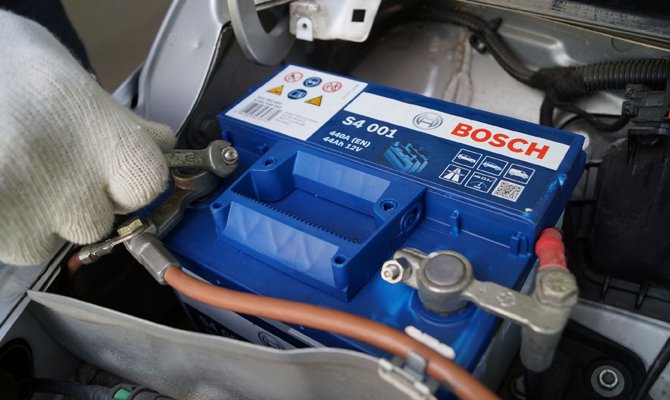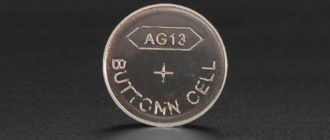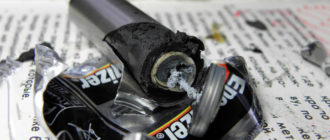The process of dismantling the battery from the car as a rule does not cause certain problems for car owners. In most cases, motorists carry out such work independently, often neglecting basic technical requirements and safety rules.
Incorrect battery dismantling can lead to negative consequences:
- mechanical or electrical damage to the battery;
- malfunctions of the electrical equipment of the car;
- failure of vehicle control systems;
- dangerous burn with electrolyte;
- traumatic cases.
Before disassembling the battery, you should familiarize yourself with the basic safety measures, rules and procedures for performing the necessary actions.
Content
Why do I have to remove the battery from the car
Cases of dismantling the battery in motoring practice are not isolated. The main reasons why you have to shoot are:
- replacement of a worn-out battery with a new battery;
- statement of the battery on a charge in stationary conditions;
- battery routine maintenance (electrolyte replacement, density check, performance recovery, desulfation and etc.);
- statement of the battery for temporary storage during a long parking of the car;
- driver assistance when starting a third-party car;
- vehicle repair work;
- the battery terminal (usually negative) is removed to reset the individual settings of some systems, error codes of car control units (without removing the battery);
- dismantling the battery in an emergency (if the engine compartment is damaged);
- pre-sale preparation;
- engine washing with special equipment (if the battery is installed under the hood);
- cleaning the cabin or trunk (in the case when the battery is properly installed there).
This is the most common case, but in life there can be much more.
Safety measures when removing the battery
When performing work on removing the car battery, safety precautions should be observed. The main hazards in battery maintenance are:
- a large mass of battery;
- the possibility of high currents flowing through the battery terminals, which can lead to a thermal burn, damage to the retina in case of sparking;
- aggressive electrolyte that causes chemical damage when it enters the human body.
Measures for safe dismantling of the battery:
- Work should be done with mittens, which should be removed immediately if electrolyte gets on them.
- Work clothes should be made of natural fabrics (cotton, wool).
- When removing the battery, it is recommended to use hard shoes (boots, work leather shoes).
- To protect the cornea from accidental chemical damage, it is necessary to use safety glasses.
- Before removing the battery, check the integrity of the portable handle.
Procedure and Precautions
Before proceeding with the removal of the battery, you need to make sure that the engine is turned off. If you remove the battery during engine operation, then at this time all the control units of the car will be supplied with voltage from the generator.
If the generator voltage regulator-relay is faulty, then increased unstabilized voltage (more than 15.5 Volts) can be supplied to the electronic units. This in most situations leads to the failure of auto electronics. Repair is extremely complicated and expensive.
Never remove the battery while the engine is running!
Before removing the terminals from the battery, make sure that the ignition is off. If you disconnect the battery with the ignition on, very serious problems with the immobilizer are possible. If a failure occurs in the immobilizer system, the key is “untied”, without an auto electrician, further engine starting will be problematic.
Procedure for removing the battery:
- Determine where to install the battery. If it is installed in the trunk, make room for work. When the battery is under the seat, it is necessary to dismantle or raise the slide according to the operating instructions of the vehicle.
- To dismantle fastening of the storage battery to a regular place. This can be a special bracket or bracket. Usually they are removed using a key of 10 or 13.
- In the case when a gas outlet is connected to the battery (a tube for removing gaseous products from the plate capacity), disconnect it. It is advisable to place the tube in a pre-prepared container.
- Proceed to disconnect the terminals. In order to properly disconnect the terminals, the following removal sequence must be observed:
- the negative (minus) terminal should be removed first (in this case, if you accidentally touch the key to body metal parts or the mass of the car, there will be no short circuit);
- after disconnecting the negative terminal, proceed to disconnect the positive terminal.
If one of the terminals is “stuck”, you can use silicone grease or brake fluid to release it. WD-40 is better not to use, as it has a high degree of aggressiveness towards lead.
Do not use strong mechanical stresses when removing the terminals!
Even a slight crack in the contact area will lead to the further formation of chemical oxides at the terminals. To dismantle the terminals, a 10 key is usually used.
- After disconnecting the terminals, remove the battery from its original place and place on a stable surface.
After the battery has been removed from the car, it is recommended to wipe it from moisture and dirt, after which it will be possible to begin the planned work with it.
Have you had to remove the battery from the car? Then tell us in the comments about your experience, this will greatly help other motorists and will make the material more complete and accurate.









